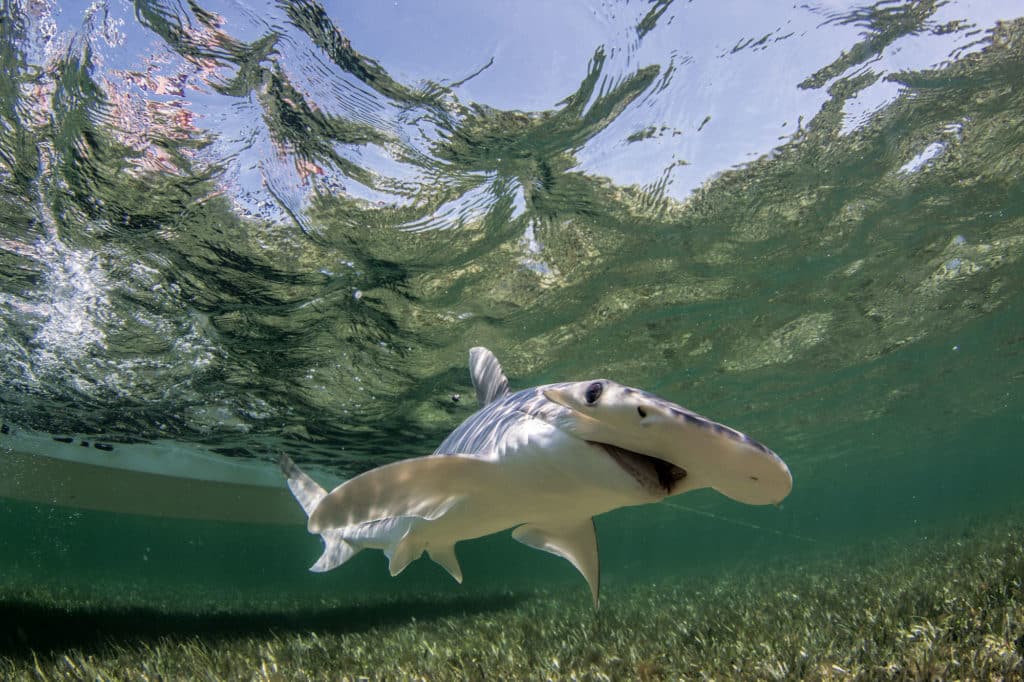
If you’d like youngsters to get into fishing, there’s no better way to introduce them to the sport than by chartering an experienced, patient captain to catch sharks. Kids find shark fishing fun, a little scary, exhilarating, enlightening and almost always memorable. The most difficult issue can be figuring out who enjoyed a shark trip more: the kids, the parents or the guide.
“When my phone rings with a parent who says, ‘My child would like to catch a shark,’ I get fired up because I want them to have a blast and make a fantastic memory,” Capt. Scott Simpson says. “I want to make a good memory for that boy or girl, whether they’re 7 or 15 years old.”
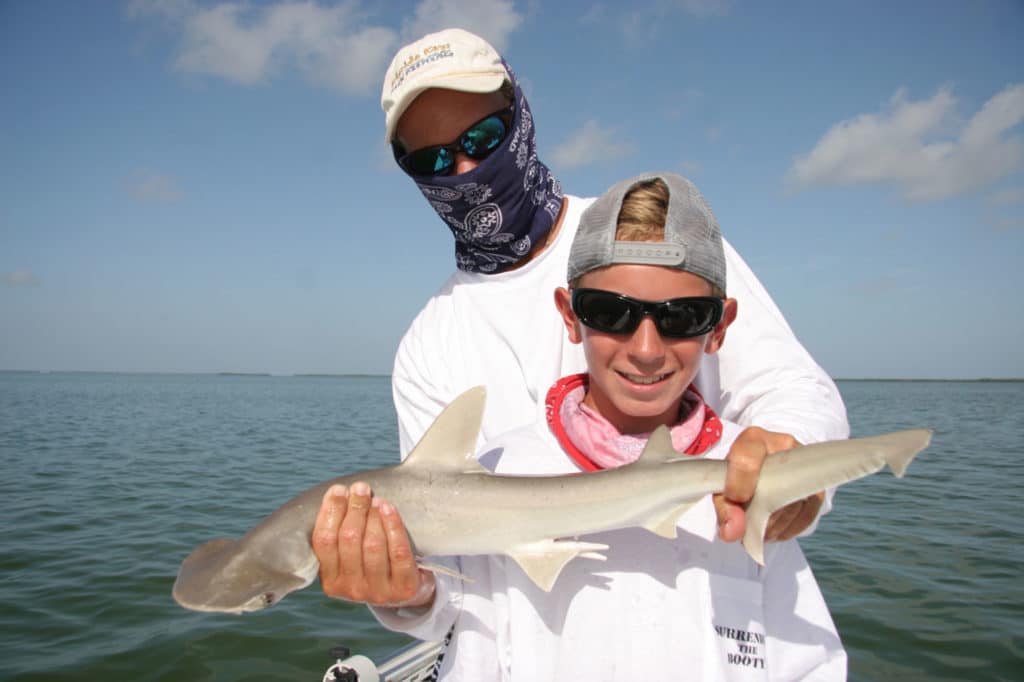
Simpson, who fishes out of Long Beach, Mississippi, says his area hosts an abundance of small coastal sharks in spring and summer, anywhere from man-made reefs a mile off the beach to barrier islands 12 to 25 miles into the Gulf of Mexico. That means plenty of opportunities for his young customers, many of whom are 8- to 12-year-olds who have never caught a shark.
“They go out not knowing what to expect,” Simpson says. “All of a sudden, it happens: That shark hits and starts pulling out line. You’re there to coach them if they need you. With the first one, I might have to help them click the reel into gear and fight the fish, and they usually do pretty darn good. I think a child is a better listener than a parent.
“After they get the shark in and see it, touch it and take a picture, that second one is more exciting than the first one. They know what to expect, how hard it’s going to pull.”
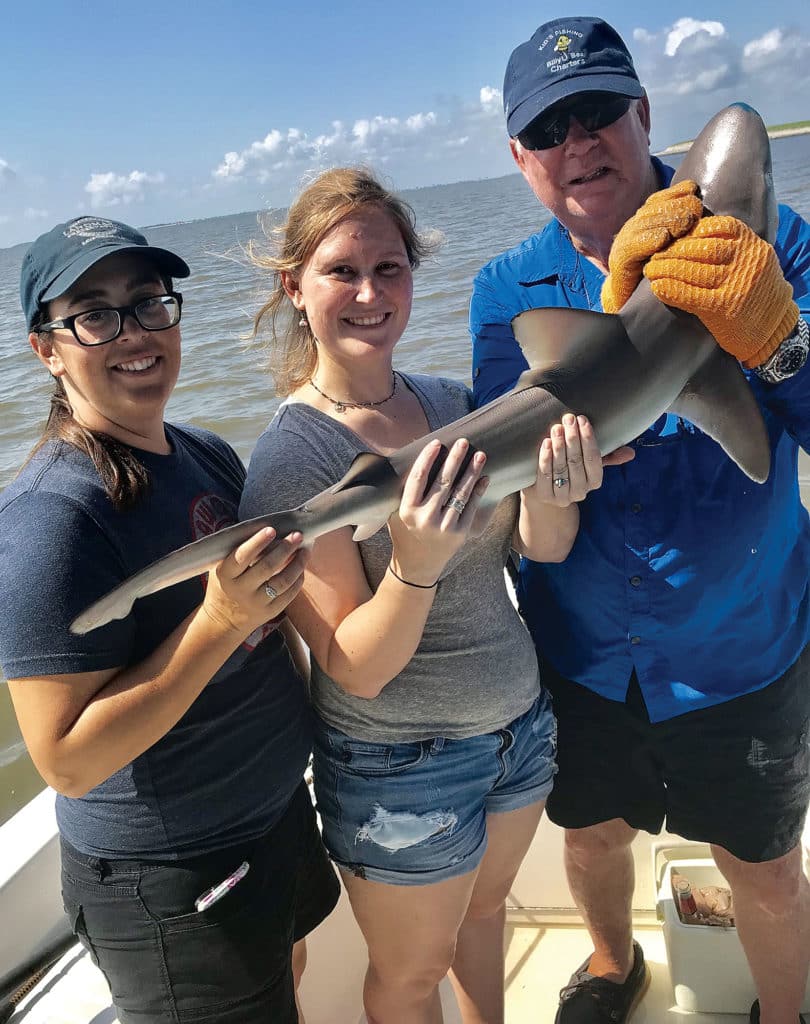
Lifetime Memories
Best of all for Simpson is when he hears back from the parents of kids who caught their first shark with him. “There’ve been dozens of times where a week or two or a month later, I’ll get a text or email from a customer that their daughter or son is still talking about that shark, and they can’t wait to come back next year,” Simpson says. “That’s what gives me pride in what I do: to make memories for the next generation of fishing men and ladies.”
Happy customers and repeat business also mean a lot to Capt. Billy Bice of St. Simons Island, Georgia. He cites a family that started fishing with him when their son was 8. This past summer, the now-18-year-old and his father fished with Bice for the 10th consecutive year.
One of Bice’s best memories is a trip with a 10- or 12-year-old boy with autism. He started the trip shy and withdrawn, but after catching a shark and then a whiting doubleheader, he was a different person.
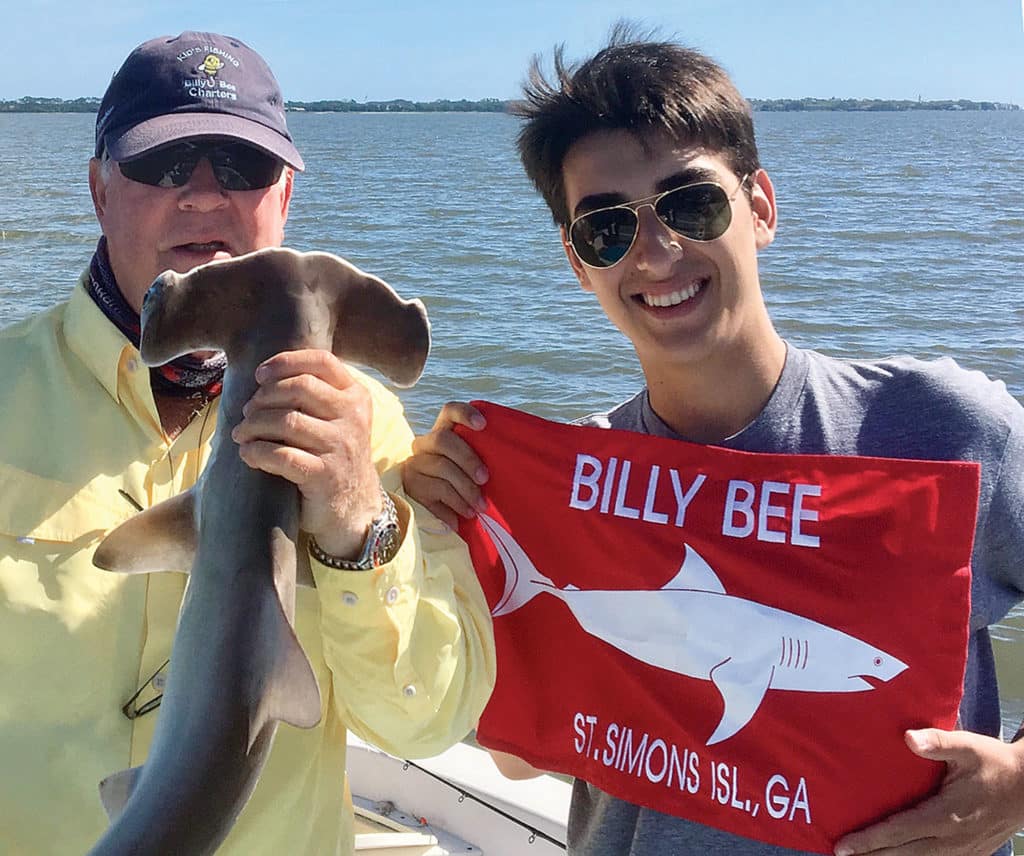
“He really came out,” says Bice, a retired educator who specializes in family shark-fishing trips. “He was so proud, his mom told me that he said, ‘I bet you Capt. Billy tells everybody about my catch.’
“Seven-year-olds don’t care what they catch or how many they catch, but if they can catch a shark or a stingray, that is awesome to them. A stingray, a shark and a whiting — a Billy Bee trash-can slam — is big on my boat.
“When they leave me, hopefully they’ve had an experience that’s more than a fishing trip, more than a boat ride; it’s a lifetime memory. If I accomplish that, they’ve gotten their money’s worth and I’ve gotten mine.”
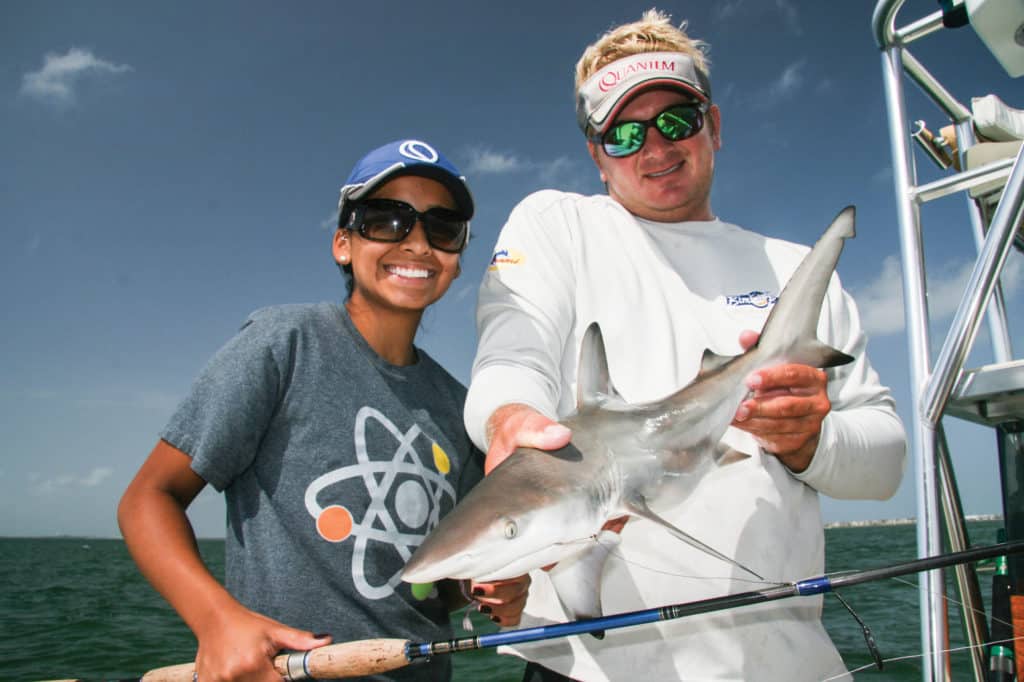
Species Choices
The size of shark they catch doesn’t always matter to kids: A 5-pound bonnethead can generate extreme excitement for a youngster, the same as a 100-pound bull shark.
“One thing about kids is they all love sharks,” says Capt. Dennis Forgione, who fishes his charter boat Free Spool out of North Miami Beach, Florida. Like many captains who take kids shark fishing, Forgione targets a variety of species, although sometimes a lone marauder not on the usual target list shows up unexpectedly.
On one offshore trip, Forgione’s young anglers were catching yellow jacks, yellowtail snapper, kingfish and bonito when a 12-foot hammerhead shark appeared out of nowhere and ate a bonito that had been reeled alongside his boat. His anglers also have caught sandbar, spinner and blacktip sharks offshore, and bonnethead and lemon sharks in Biscayne Bay.
The bay is Forgione’s go-to location when seas kick up offshore. He either anchors and drifts baits back or uses a fishing kite to send his baits out to the channel.
Bice and Simpson put younger kids on small Atlantic sharpnose and finetooth sharks. Teenagers can handle big blacktip and spinner sharks, which can range from 5 to 90 pounds in Mississippi, Simpson says.
“Blacktips and spinners provide line-pulling, rod-bending, drag-screaming, fast-paced action. It’s definitely fun for the entire family,” he adds. “The spinners are great fun for families and kids to catch because they give us a nice visual, acrobatic fight, jumping multiple times.”
Capt. Billy Miller, who fishes out of St. Petersburg, Florida, has put his young anglers on everything from 3-foot-long bonnethead sharks to 13-foot hammerheads in and around Tampa Bay.
“We want it to be fun for everybody,” Miller says. “If we have really young kids, we anchor up over grass, chum with minnows, catch Spanish mackerel and bluefish and trout, and then the sharks move in. Young kids fish with trout poles and can catch bonnetheads. Those are always cool for the kids because they’re not so big that the kids can’t handle them.”
Sometimes, though, it takes a team effort, especially when a big hammerhead or bull shark shows up. “A lot of kids don’t care how many of their buddies help them reel it in, as long as they get it to the boat,” Forgione says. If a shark can’t be kid-handled, captains often leave the rod in the holder and let the child fight the fish without having to support the tackle.
“A lot of times, you have kids who’ve brought a buddy or two with them,” Miller says. “One kid’s holding the rod, one kid’s holding the reel, and one kid’s holding the handle, and they’re having more fun than they know what to do with.”
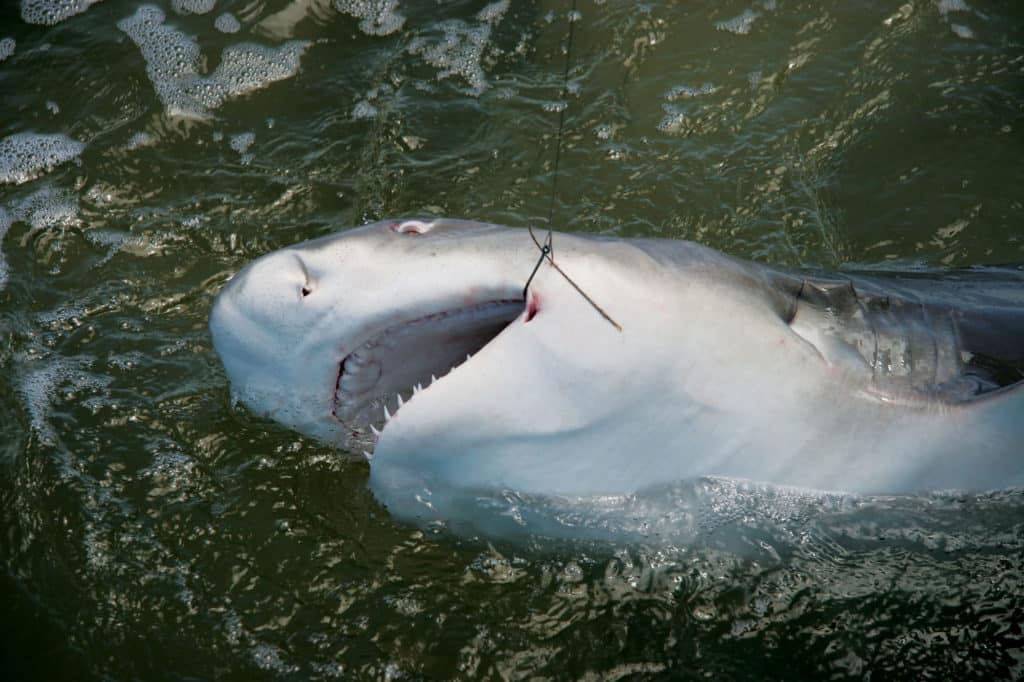
Picture Perfect
The captains I spoke with pointed out that shark fishing makes for great videos and photos. They’ll bring small sharks in the boat for quick photography, although the definition of small varies.
“I trust sharks about as far as I can throw a 300-pound man,” Simpson says. “If I can put my hand around them, I’ll grab them behind the head with my left hand and might let the kids hold the tail.”
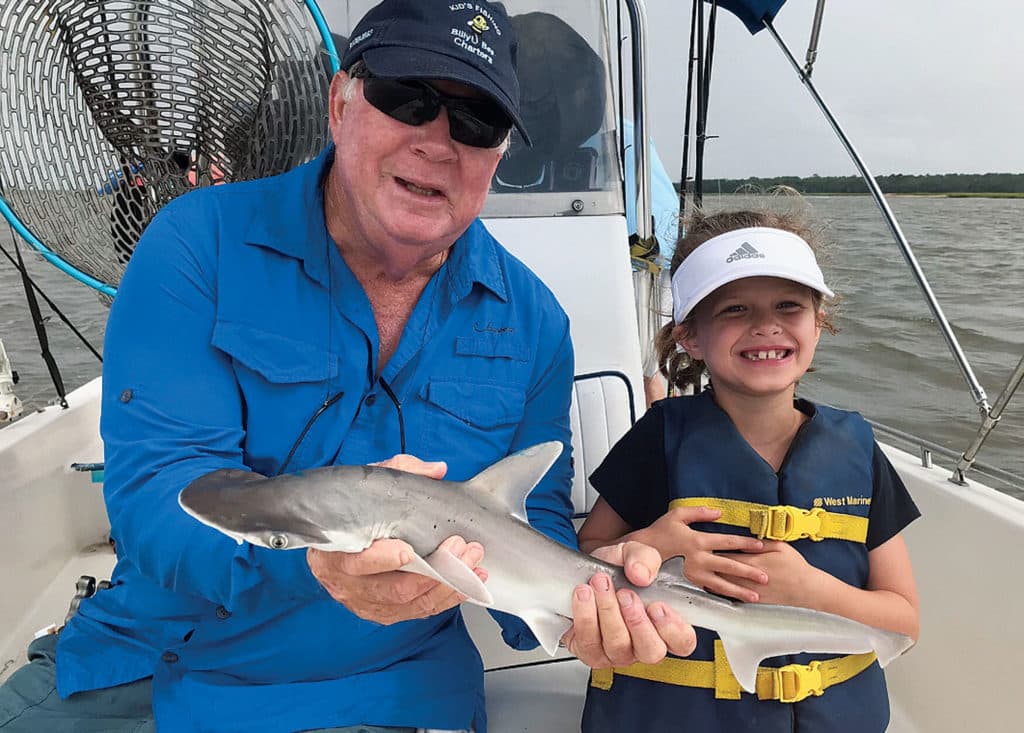
Forgione lets kids touch big sharks held by his mate alongside the boat. Bice brings small sharks into his boat so kids can touch their skin, and he’ll show them the shark’s unique nictitating eyelids. Parents often take photos of the kids holding a Billy Bee shark-release flag while Bice holds the shark.
Miller is more extreme: He brings blacktip sharks weighing 50 to 100 pounds into his boat for a moment.
“We flip them in the boat and take a photo, and people freak out,” Miller says. “They make for beautiful pictures.”
Read Next: 40 Greatest World-Record Catches by Junior Anglers
Because sharks have only cartilage, and not bone, in their bodies, they can bend double and quickly snap at a human finger or foot. So handling is something best left to the pros. In fact, the Florida Fish and Wildlife Conservation Commission suggests anglers leave sharks in the water alongside a vessel when taking pictures and releasing the fish.
In addition, state, regional and federal laws govern the harvest of sharks, and permits are required even for recreational fishing in some circumstances. Knowledgeable guides secure the proper paperwork and follow the rules.
However, keeping a shark to eat ranks as the least important part of the trip. The real appeal of catching sharks is turning kids into lifelong anglers.
Shark Fishing Nuts and Bolts
Capt. Billy Bice
St. Simons Island, Georgia
912-269-9983
billybeecharters.com
Tackle: Ugly Stik rod, Zebco reel, 2-ounce sliding sinker, plastic bead, swivel, 8 inches of nylon-coated 60-pound steel leader, 4/0 circle hook
Bait: whiting chunk
Capt. Dennis Forgione
North Miami Beach, Florida
305-582-5445
freespoolsportfishing.com
Offshore: Penn Carnage II rod, Penn 30 International reel, 80-pound red SpiderWire braid. Double a section of the main line and slip a swivel over it. Use 12 to 15 inches of 60- or 80-pound mono to tie a 2- to 3-pound sinker to the swivel. Tie a snap swivel onto the end of the main line, then add 20 to 25 feet of 300-pound mono with a crimped end, 6 or 7 feet of No. 12 wire, and a hand-size circle hook.
Inshore: 80-pound mono leader, short piece of No. 9 wire
Bait: small bonito, bonito slab or bonito head for offshore; bonito chunk or live pinfish inshore
Capt. Billy Miller
St. Petersburg, Florida
813-363-9927
captainbillymiller.com
For small sharks: 7½-foot spinning rod, size 20 or 30 reel, 15-pound braid, 2 to 3 feet of 20-pound monofilament leader, long-shank 2/0 mackerel hook or 10 inches of No. 4 wire (38-pound-test), 2/0 J hook
For bigger sharks: 9-foot spinning rod, 4/0 reel, 50-pound braid, 5 feet of seven-strand wire, 9/0 Gamakatsu J hook
Bait: headless menhaden hooked in the tail, Spanish mackerel chunk, bonito (offshore)
Capt. Scott Simpson
Long Beach, Mississippi
228-669-6204
captainscottsimpson.com
Tackle: Medium-heavy, 7-foot 30- to 60-pound rod, Penn Fathom 40LW reel, 50-pound high-viz green monofilament, barrel swivel crimped to 3 feet of plastic-coated seven-strand wire (135-pound-test), 2-ounce egg sinker, crimp, 8/0 J hook
Bait: cut mullet or croaker, live pinfish, ladyfish, sand trout, mullet, croaker
It Ain’t Easy When You’re Queasy
Catching sharks can hook youngsters on fishing for life, but seasickness can turn them off, no matter how great the fishing.
“I tell everybody, ‘Listen, it’s really not a rule, but no one’s allowed to get seasick,’” St. Simons Island, Georgia, Capt. Billy Bice says. “I say, ‘Mom, if anybody starts to feel sick, you tell me.’”
Bice keeps ginger ale on his boat for anglers feeling the initial effects of seasickness. If seas are bumpy, he almost always retreats to calmer inshore waters. If even those back rivers and sounds are bad enough to make people sick, he cancels the trip.
Capt. Dennis Forgione fishes offshore of North Miami Beach, Florida, but he quickly heads into the protected waters of Biscayne Bay if conditions start to bother anglers. “If it’s a miserable experience, that kid’s never going to go again,” says Forgione, who always keeps ginger candy on his boat to help with seasickness. “I’ll tell the parents, ‘Hey, look, we’ve got to go in.’ I can always salvage the trip. If I see a kid’s getting sick, I’ll go into the bay, and now they’re awake again and having fun.”
Seasickness is rarely an issue for Capt. Scott Simpson’s anglers, who might fish for sharks 25 miles into the Gulf of Mexico out of Long Beach, Mississippi. Simpson, who served in the U.S. Coast Guard, notes that some people can worry themselves sick. “One thing I always tell my customers when they call to schedule a trip is, ‘If you’re thinking about seasickness, then get the patch or the bracelet or take a Dramamine.’ It’s all a mental thing,” Simpson says. “Be a little proactive.”
Like Bice and Forgione, Simpson finds alternatives if seas in the Gulf disturb his anglers. “That’s one thing we’re blessed with here on the Mississippi coast,” he says.
“I can always find an area with some protected water to fish.”
Although many captains provide water and other drinks for their customers, parents should bring plenty of their kids’ favorite beverages and snacks. “It’s amazing how much a little kid will eat,” Bice says, adding that parents should also bring hats for their kids to wear and sunscreen.








